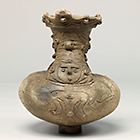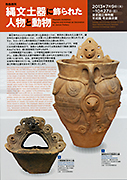Japanese Archaeology and Special Exhibition (Heiseikan) Japanese Archaeology Gallery
July 9, 2013 (Tue) - October 27, 2013 (Sun)
One of the tools most produced by people in the Jomon period (ca. 11,000 BC – ca. 5th century BC) was pottery vessels for cooking. Well-known examples of Jomon-period ritual implements are dogu (clay figurines) as well as ceramic objects in the shape of animals; however, there are also ritual pottery vessels with people- and animal-shaped decorations.
It appears that pottery vessels with this type of decoration began being made in the early Jomon period. In the mid-Jomon period many vessels were made in the Chubu and Kanto regions of Japan, while from the late-middle Jomon period to the final Jomon period, many were produced in northeastern Japan. They were also created in the following Yayoi period (ca. 5th century BC – AD ca. 3rd century).
This exhibition introduces the connection between pottery vessels and their decorations in the shape of people or animals. It also investigates, through the designs and adornments on vessels, the beliefs that people of ancient times stored in vessels. The displayed objects include those in the collection of the education board of Hokuto City, Yamanashi prefecture, which has revealed a rich cultural source of mid-Jomon period materials in recent years.


